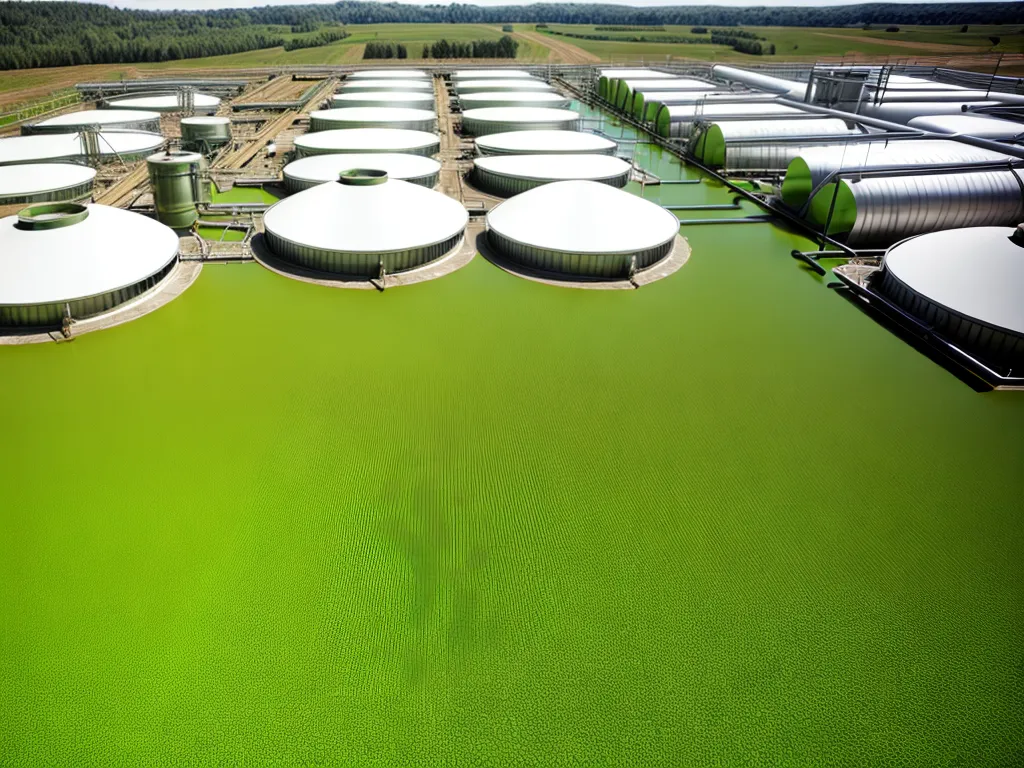
How to Use Algae for Small-Scale Biogas Production
What is Algae Biogas?
Algae biogas is a renewable energy source produced by anaerobic digestion of algae biomass. In this process, algae are grown in ponds or photobioreactors, harvested, and then fed into an anaerobic digester. Inside the digester, bacteria break down the algae biomass in the absence of oxygen, releasing biogas as a byproduct.
The main components of algae biogas are methane (CH4) and carbon dioxide (CO2). Methane is the valuable component that can be used similarly to natural gas for heating, electricity generation, and transportation fuel. Algae biogas typically has 50-70% methane content, compared to 60-80% for natural gas.
Benefits of Using Algae for Biogas Production
There are several advantages to using algae for biogas production compared to other feedstocks:
-
High yields: Algae have very high biomass productivity compared to terrestrial crops, allowing more biogas to be produced per unit of land area. Yields of 20-30 tonnes of algae biomass per hectare per year are feasible.
-
Grow on non-arable land: Algae can be grown on non-arable land unsuitable for food crops, avoiding competition for land use. Saline water or wastewater can be used for cultivation.
-
Use waste resources: Algae growth can utilize waste resources like CO2, agricultural runoff, and industrial wastewater as nutrients. This provides waste remediation.
-
Co-products: After anaerobic digestion, the algae residue can be used for fertilizer, animal feed, or extracted for other co-products.
Algae Species for Biogas Production
Many different algae species can be used for biogas production. Some of the most suitable ones include:
-
Microalgae - Chlorella, Scenedesmus, and Chlamydomonas species typically give high biomass and biogas yields.
-
Macroalgae - Species like Ulva, Cladophora, and Sargassum can be produced in marine environments.
-
Cyanobacteria - Often called blue-green algae, such as Spirulina and Anabaena, grow quickly and contain high protein.
Ideally, fast growing species with high carbohydrate or lipid content are preferred, as these components are easiest to break down into biogas. Local species adapted to the climate should be chosen.
Algae Cultivation Systems
Algae can be cultivated using open ponds or closed photobioreactor systems:
Open Ponds
- Less expensive to construct than photobioreactors
- Exposed to the environment, prone to contamination
- Maximum depth of 30 cm to allow light penetration
- Paddlewheels used to circulate and mix culture
- Raceway configuration improves circulation
Photobioreactors
- Enclosed systems made of glass or plastic tubes/panels
- Better control, higher productivity, less contamination
- More complex and expensive to build and operate
- Artificial lighting can be used to maximize growth
For small-scale biogas production, simple open ponds like raceways may be most economical.
Biogas Digester Design
Common digester designs suitable for small-scale algae biogas include:
-
Covered lagoons - Least expensive, basic earthen pit lined with clay, plastic or concrete. Covered with plastic or tent to collect biogas.
-
Plug flow digesters - Underground concrete tanks, algae flows and digests in one direction. Good for drier algae feedstocks.
-
Complete mix digesters - Tank is mechanically mixed during digestion, giving more uniform conditions. Better for wetter feeds like algae slurry.
-
Fixed dome digesters - Domed concrete lid rises and acts as gas storage. No moving parts. Well suited to small-scale warm climates.
For algae biogas, wet digestion systems like complete mix or fixed dome digesters are likely most appropriate. The digesters should be sized to provide a minimum 15-20 day hydraulic retention time. Heating the digester can increase biogas production in cold climates.
Algae Harvesting and Pre-Treatment Methods
Before feeding algae into the anaerobic digester, it needs to be concentrated and harvested from the cultivation ponds or photobioreactors. Some options include:
-
Sedimentation - Letting algae settle out by gravity if buoyant strains are used. Very simple but can be slow.
-
Centrifugation - Spinning to concentrate algae. Effective but energy intensive. Works best for small volumes.
-
Dissolved air flotation - Bubbling air through algae suspension causes algae to float for removal. Relatively affordable.
-
Flocculation - Chemical flocculants make algae aggregate into larger clumps for faster separation from water.
-
Filtration - Using filters like cloth filters or chamber filter presses to dewater algae.
If the raw algae has a solid content under 5-10%, it may require concentration before anaerobic digestion to avoid digester volumes becoming too large. Simple gravity settling or flocculation are likely suitable pre-treatment methods at small-scale.
Key Factors Affecting Biogas Production
To maximize biogas production from algae, some key factors need to be considered:
-
Digester temperature - Heat between 30-38°C speeds digestion. Insulation and heating can help in cold climates.
-
Algae composition - Lipid and carbohydrate-rich strains will produce more methane than protein-rich ones.
-
Algae pre-treatment - Mechanical, chemical or thermal pre-treatment can improve digestibility.
-
Retention time - Hydraulic retention times of 15-40 days are typical. Longer gives more complete digestion.
-
Digester loading rate - Moderate organic loading rates of 1-3 kg/m3/day are recommended.
-
Co-digestion - Adding high carbon wastes like crop residues can improve C:N ratio and biogas yield.
Carefully controlling these parameters allows algae biogas systems to reach their full potential methane production.
Conclusion
Algae are an excellent renewable feedstock for small-scale biogas production. With modest investment in open ponds, digesters, and harvesting equipment, energy independence through homegrown methane fuel can be achieved. Correctly sizing the system and optimizing operational parameters will lead to long-term success. Algae biogas provides a sustainable energy solution while making use of wastewater resources.